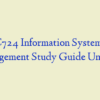Description
C701: Ethical Hacking – Pre-Assessment Questions
- Hacker is a person who illegally breaks into a system or network without any authorization to destroy, steal sensitive data or to perform any malicious attacks.
Black hat hackers are: - In order to compromise or to hack a system or network the hackers go through various phases of the hacking.
What is the first hacking phase that hackers perform to gather information about a target prior to launching an attack? - Defense-in-depth is a security strategy in which several protection layers are placed throughout an information system. It helps to prevent direct attacks against an information system and data because a break in one layer only leads the attacker to the next layer.
- Penetration testing is a method of actively evaluating the security of an information system or network by simulating an attack from a malicious source.
Which of the following technique is used to simulate an attack from someone who is unfamiliar with the system?
- So, Which of the following scanning technique attackers use to bypass firewall rules, logging mechanism, and hide themselves as usual network traffic?
- Which of the following scan only works if operating system’s TCP/IP implementation is based on RFC 793?
- OS fingerprinting is the method used to determine the operating system running on a remote target system. It is an important scanning method, as the attacker will have a greater probability of success if he/she knows the OS. Active stack fingerprinting is one of the types of OS fingerprinting.
Which of the following is true about active stack fingerprinting? - Proxy is a network computer that can serve as an intermediary for connecting with other computers.
Which of the following sentence is true about a proxy?
- IP spoofing refers to the procedure of an attacker changing his or her IP address so that he or she appears to be someone else.
Which of the following IP spoofing detection technique succeed only when the attacker is in a different subnet? - Enumeration is defined as the process of extracting user names, machine names, network resources, shares, and services from a system.
Which of the following enumeration an attacker uses to obtain list of computers that belongs to a domain? - Network Time Protocol (NTP) is designed to synchronize clocks of networked computers. Which of the following port NTP uses as its primary means of communication?
- Rootkits are kernel programs having the ability to hide themselves and cover up traces of activities. It replaces certain operating system calls and utilities with its own modified versions of those routines. Which of the following rootkit modifies the boot sequence of the machine to load themselves instead of the original virtual machine monitor or operating system?
- Steganography is a technique of hiding a secret message within an ordinary message and extracting it at the destination to maintain confidentiality of data.
Which of the following steganography technique embed secret message in the frequency domain of a signal?
- A virus is a self-replicating program that produces its own code by attaching copies of it into other executable codes.
Which of the following virus evade the anti-virus software by intercepting its requests to the operating system? - Lawful intercept is a process that enables a Law Enforcement Agency (LEA) to perform electronic surveillance on a target as authorized by a judicial or administrative order.
Which of the following statement is true for lawful intercept? - Sniffer turns the NIC of a system to the promiscuous mode so that it listens to all the data transmitted on its segment. It can constantly read all information entering the computer through the NIC by decoding the information encapsulated in the data packet. Passive sniffing is one of the types of sniffing. Passive sniffing refers to.
ARP Spoofing involves constructing a large number of forged ARP request and reply packets to overload:
- Denial of Service (DoS) is an attack on a computer or network that prevents legitimate use of its resources. In a DoS attack, attackers flood a victim system with non-legitimate service requests or traffic to overload its resources, which prevents it from performing intended tasks. Which of the following is a symptom of a DoS attack?
- Session Hijacking refers to the exploitation of a valid computer session where an attacker takes over a session between two computers.
Which of the following factor contribute to a successful session hijacking attack? - Buffer Overflow occurs when an application writes more data to a block of memory, or buffer, than the buffer is allocated to hold. Buffer overflow attacks allow an attacker to modify the ___________ in order to control the process execution, crash the process and modify internal variables.
- Which wireless standard has bandwidth up to 54 Mbps and signals in a regulated frequency spectrum around 5 GHz?
- Which device in a wireless local area network (WLAN) determines the next network point to which a packet should be forwarded toward its destination?
- Wireless antenna is an electrical device which converts electric currents into radio waves, and vice versa. Which of the following antenna used in wireless base stations and provides a 360 degree horizontal radiation pattern?
Wi-Fi Protected Access (WPA) is a data encryption method for WLANs based on 802.11 standards.
- It improves on the authentication and encryption features of WEP (Wired Equivalent Privacy). Temporal Key Integrity Protocol (TKIP) enhances WEP by adding a rekeying mechanism to provide fresh encryption and integrity keys. Temporal keys are changed for every ___________.
- Firewall is a set of related programs, located at a network gateway server that protects the resources of a private network from users from other networks. A firewall examines all traffic routed between the two networks to see if it meets certain criteria.
Packet filter is one of the categories of firewall. Packet filtering firewall works at which of these layers of the OSI model? - Keystroke loggers are stealth software packages that are used to monitor keyboard activities. Which is the best location to place such keyloggers?
- You have invested millions of dollars for protecting your corporate network. You have the best IDS, firewall with strict rules and routers with no configuration errors.
Which of the following techniques practiced by an attacker exploits human behavior to make your network vulnerable to attacks? - Firewalls are categorized into two; namely hardware firewall and software firewall.
Identify the correct statement for a software firewall.
- Nmap is a free open source utility, which is designed to rapidly scan large networks.
- So, Identify the Nmap Scan method that is often referred to as half open scan because it does not open a full TCP connection.
- As a system administrator, you are responsible for maintaining the website of your company which deals in online recharge of mobile phone cards. One day to your surprise, you find the home page of your company’s website defaced. What is the reason for webpage defacement?
- Which of the following protocols are susceptible to sniffing?
- RSA is a public-key cryptosystem developed by MIT professors Ronald L. Rivest, Adi Shamir, and Leonard M. Adleman in 1977 in an effort to help ensure Internet security. RSA uses modular arithmetic and elementary number theory to do computations using two very large prime numbers. Identify the statement which is true for RC6 algorithm:
- Password cracking is a technique used to extract user’s password of application/files without the knowledge of the legitimate user.
Which of the password cracking technique will the attacker use if he/she gets some information about the password to crack?
- Secure Hashing Algorithm (SHA) is an algorithm for generating cryptographically secure one-way hash, published by the National Institute of Standards and Technology as a U.S. Federal Information Processing Standard. What is the block (word) size used by SHA-512 algorithm?
- Which of the following cryptographic attack refers to extraction of cryptographic secrets (e.g. the password to an encrypted file) from a person by coercion or torture?
- Which of the following is a mutation technique used for writing buffer overflow exploits in order to avoid IDS and other filtering mechanisms?
- Firewall implementation and design for an enterprise can be a daunting task. Choices made early in the design process can have far-reaching security implications for years to come. Which of the following firewall architecture is designed to host servers that offer public services?
An intrusion detection system (IDS) gathers and analyzes information from within a computer or a network.
- So identify the possible violations of security policy, including unauthorized access, as well as misuse. Attackers use various IDS evasion techniques to bypass intrusion detection mechanisms. Which of the following evasion technique rely on Time-to-Live (TTL) fields of a TCP/IP packet?
- Attackers craft malicious probe packets and scan for services such as HTTP over SSL (HTTPS), SMTP over SSL (SMPTS) and IMAP over SSL (IMAPS) to detect honeypots in a network. Which of the following condition shows the presence of a honeypot?
- So, Identify the denial-of-service attack that is carried out using a method known as “bricking a system.” Unlike other DoS attacks, it sabotages the system hardware, requiring the victim to replace or reinstall the hardware.
- Some viruses affect computers as soon as their code is executed.
- Another viruses lie dormant until a pre-determined logical circumstance is met. Identify the virus that modifies the directory table entries so that directory entries point to the virus code instead of the actual program.
- Which of the following Wi-Fi chalking method refers to drawing symbols in public places to advertise open Wi-Fi networks?
- Wired Equivalent Privacy (WEP) is an IEEE 802.11 wireless protocol which provides security algorithms for data confidentiality during wireless transmissions. WEP uses stream cipher RC4 for confidentiality, and the CRC-32 checksum for integrity of wireless transmission. What is the size of WEP initialization vector (IV)?
Bluetooth hacking refers to exploitation of Bluetooth stack implementation vulnerabilities to compromise sensitive data in Bluetooth-enabled devices and networks.
- Which of the following Bluetooth attack refers to sending unsolicited messages over Bluetooth to Bluetooth-enabled devices such as PDA and mobile phones?
- Enumeration is defined as the process of extracting user names, machine names, network resources, shares, and services from a system. Which of the following command can be used in UNIX environment to enumerate the shared directories on a machine?
- CAM table in switch stores information such as MAC addresses available on physical ports with their associated VLAN parameters. What happens when the CAM table is full?
- Identify the web application attack where attackers exploit webpage vulnerabilities to force an unsuspecting user’s browser to send malicious requests they did not intend.
- In the victim holds an active session with a trusted site and simultaneously visits a malicious site, which injects an HTTP request for the trusted site into the victim user’s session, compromising its integrity
- Jason, a penetration tester, is testing a web application that he knows is vulnerable to an SQL injection. As a results of the injection are not visible to him.
- He tried waitfor delay command to check the SQL execution status which confirmed the presence of the SQL injection vulnerability. Which type of SQL injection Jason is attempting on the web application?
Consider the attack scenario given below:
- Step 1: User browses a web page,
- Step 2: Web server replies with requested page and sets a cookie on the user’s browser.
- So, Step 3: Attacker steals cookie (Sniffing, XSS, phishing attack).
- Step 4: Attacker orders for product using modified cookie.
- Step 5: Product is delivered to attacker’s address Identify the web application attack.
- An intrusion detection system (IDS) gathers and analyzes information from within a computer or a network, to identify the possible violations of security policy, including unauthorized access, as well as misuse.
Which of the following IDS detection technique detects the intrusion based on the fixed behavioral characteristics of the users and components in a computer system? - So, Check out our latest Tutorials and Courses on PSY 205.




